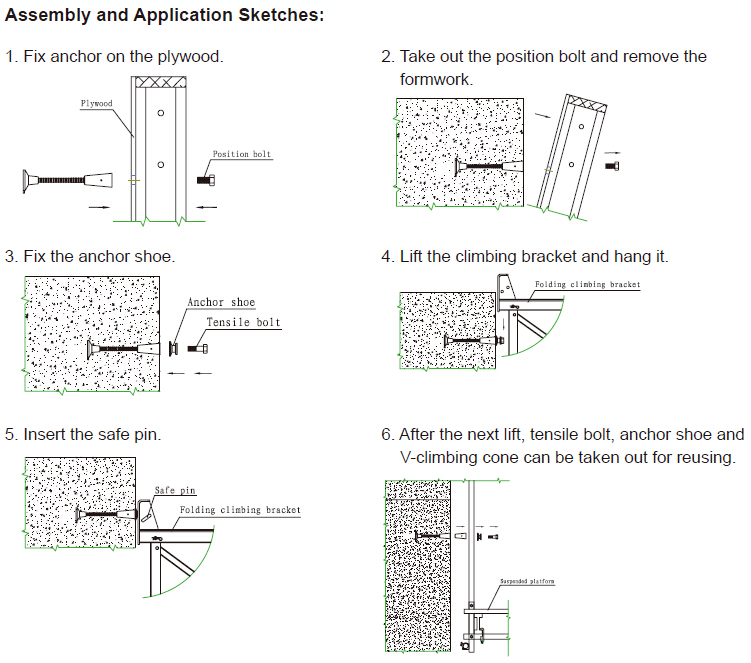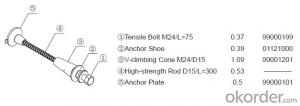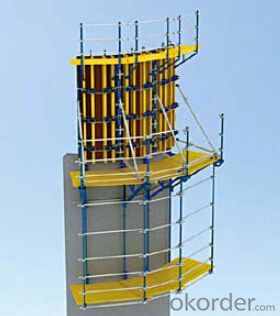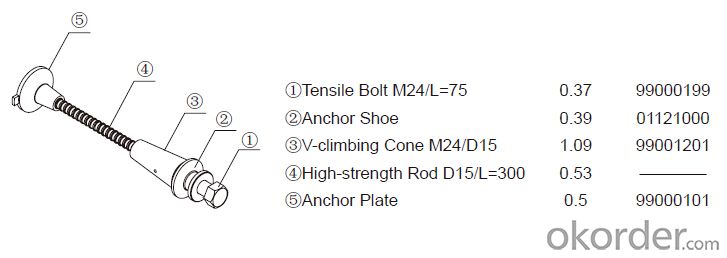Climbing-Platform CP190 for formwork and scaffolding system
- Loading Port:
- Tianjin
- Payment Terms:
- TT OR LC
- Min Order Qty:
- 50 m²
- Supply Capability:
- 1000 m²/month
OKorder Service Pledge
OKorder Financial Service
You Might Also Like
Climbing Platform CP190
Climbing bracket CP190 is mainly used as operating platform during construction. It can be used
on the vertical wall and arced wall. The bracket hang on the anchor system and all the load are
supported by anchor system. It’s convenient to assemble and dismantle, the construction is easy,
rapid and safe.
Anchor System:
Anchor system is the most important supporting part. The system is made of five parts shown
below. There into, tensile bolt, anchor shoe and V-climbing cone can be taken out for reusing.

- Q: Can steel formwork be used for both small-scale and large-scale construction projects?
- Yes, steel formwork can be used for both small-scale and large-scale construction projects. Steel formwork is highly versatile and can be customized to meet the specific requirements of any construction project. It offers excellent durability and strength, making it suitable for withstanding the pressures exerted during large-scale projects. Additionally, steel formwork can be easily assembled and disassembled, allowing for efficient use on both small and large construction sites. Furthermore, steel formwork provides a smooth and consistent finish, ensuring high-quality results regardless of the scale of the project. Therefore, whether it is a small residential building or a large commercial complex, steel formwork can be effectively utilized to achieve the desired construction objectives.
- Q: What are the different quality control measures for steel formwork construction?
- There are several quality control measures that are commonly implemented in steel formwork construction to ensure the quality and integrity of the final product. Some of these measures include: 1. Material inspection: Prior to commencing construction, all steel formwork materials should be inspected to ensure they meet the required specifications and standards. This includes checking for any defects, such as cracks or deformations, and verifying the quality of the steel used. 2. Welding inspections: Steel formwork structures often require welding for joining different components. It is crucial to conduct regular inspections of all welded joints to ensure they are properly executed and meet the necessary strength and quality standards. This involves checking for proper penetration, weld size, and alignment, as well as conducting non-destructive testing if necessary. 3. Dimensional checks: Accurate dimensions are essential for the proper assembly and functioning of steel formwork structures. Regular dimensional checks should be conducted throughout the construction process to ensure all components are fabricated to the correct specifications. This includes verifying the lengths, widths, and thicknesses of plates, beams, and other structural elements, as well as checking for proper alignment and positioning. 4. Surface finish inspection: The surface finish of steel formwork components plays a crucial role in their performance and durability. Regular inspections should be conducted to ensure that all surfaces are free from defects such as roughness, cracks, corrosion, or any other imperfections that could compromise the integrity of the structure. 5. Load testing: Load testing is an important quality control measure for steel formwork construction. It involves subjecting the formwork structures to a predetermined load to ensure they can withstand the expected forces during use. Load testing can be performed using various methods, including static or dynamic load tests, and helps ensure the structural stability and safety of the formwork. 6. Documentation and record keeping: It is essential to maintain proper documentation and records of all quality control measures performed during steel formwork construction. This includes recording the results of inspections, tests, and any corrective actions taken. Documentation facilitates traceability, provides a reference for future inspections, and helps ensure compliance with relevant standards and regulations. By implementing these quality control measures, steel formwork construction companies can ensure that their structures meet the required standards, are safe and durable, and provide reliable support during the concrete pouring process.
- Q: Can steel formwork be used for both above-water and underwater structures?
- Yes, steel formwork can be used for both above-water and underwater structures. Steel formwork is known for its durability, strength, and resistance to corrosion, which makes it suitable for various construction applications. It can withstand the water pressure and provide a stable framework for both above-water and underwater structures.
- Q: How does steel formwork contribute to the sustainability of a project?
- Steel formwork contributes to the sustainability of a project in several ways. Firstly, steel is a highly durable material, capable of withstanding the rigors of construction and repeated use over time. This means that steel formwork can be reused multiple times, reducing the need for new formwork to be manufactured for each project. By minimizing the demand for new materials, steel formwork helps to conserve natural resources and reduce the environmental impact associated with the extraction, production, and transportation of construction materials. Additionally, steel formwork offers excellent dimensional stability, which ensures precision and accuracy in construction. This reduces the likelihood of errors and rework, leading to a more efficient use of resources, including time, labor, and materials. The use of steel formwork also results in smooth and high-quality finishes, reducing the need for additional surface treatments or finishes, which can be resource-intensive and contribute to waste generation. Furthermore, steel formwork can be easily dismantled and recycled at the end of its lifespan. The steel can be melted down and repurposed for other construction projects, diverting waste from landfills and reducing the demand for virgin steel production. This closed-loop approach to material use aligns with the principles of a circular economy and helps to reduce the carbon footprint of the construction industry. Lastly, steel formwork provides enhanced safety on construction sites. Its strength and stability minimize the risk of accidents and structural failures, protecting workers and the surrounding environment. By promoting a safe working environment, steel formwork contributes to the overall sustainability of a project by preventing injuries, reducing medical costs, and minimizing the negative social and economic impacts associated with accidents. In summary, steel formwork contributes to the sustainability of a project through its durability, reusability, dimensional stability, recyclability, and safety benefits. By reducing the need for new materials, minimizing waste generation, and enhancing construction efficiency, steel formwork helps to conserve resources, mitigate environmental impacts, and promote a more sustainable construction industry.
- Q: Can steel formwork be used for tunnel construction projects?
- Steel formwork is indeed suitable for tunnel construction projects. Its durability allows it to withstand the pressure and forces exerted during tunnel construction. Moreover, it provides a robust and stable structure for pouring concrete and forming the tunnel walls. An added advantage is that steel formwork is reusable, making it a cost-effective option for tunnel construction projects. Furthermore, steel formwork can be easily tailored to meet the precise requirements of the tunnel design, enhancing efficiency and precision during construction. In conclusion, steel formwork's strength, durability, and flexibility make it an excellent choice for tunnel construction projects.
- Q: How does steel formwork affect the quality of concrete?
- Steel formwork can greatly affect the quality of concrete by providing a stable and precise mold for the concrete to be poured into. The use of steel formwork helps ensure uniformity in shape, size, and surface finish of the concrete, resulting in a higher quality and more consistent end product. The strength and durability of steel formwork also enable it to withstand the pressure exerted by the wet concrete, preventing any deformation or leakage that could compromise the integrity of the concrete structure.
- Q: How does steel formwork handle concrete shrinkage cracking?
- Concrete shrinkage cracking, which occurs as concrete dries and shrinks during curing, is specifically addressed by steel formwork. By minimizing and controlling these cracks, steel formwork plays a crucial role. During the curing process, steel formwork offers robust and rigid support to the concrete. It maintains the concrete's position, preventing any movement or shifting as it shrinks. This effectively restrains the development of large, uncontrolled cracks. Moreover, steel formwork withstands the high pressure exerted by the concrete during curing. This ensures that the formwork remains intact and free from deformation or breakage, thereby averting any cracks in the concrete. Furthermore, steel formwork allows for the incorporation of expansion joints. These joints are strategically positioned within the formwork to accommodate the anticipated shrinkage of the concrete. By providing controlled spaces for the concrete to shrink into, the formation of random cracks is minimized. Additionally, steel formwork offers the advantage of easy inspection for any cracks that might have occurred during curing. This enables early detection and repair of potential issues, preventing further cracking or damage to the concrete structure. In conclusion, steel formwork effectively addresses concrete shrinkage cracking through its strong support, resistance to pressure, provision of expansion joints, and facilitation of inspection and repair.
- Q: How does steel formwork contribute to the overall aesthetics of the structure?
- Steel formwork contributes to the overall aesthetics of a structure by providing a smooth and clean finish to the concrete surfaces. Its precise and rigid construction ensures that the concrete is accurately formed, resulting in sharp corners, straight lines, and a consistent appearance. Steel formwork also allows for the creation of intricate designs and unique architectural features, enhancing the visual appeal of the structure. Furthermore, steel formwork can be reused multiple times, reducing waste and promoting sustainable construction practices, which also adds to the overall aesthetic value of the project.
- Q: Can steel formwork be used for both reinforced and non-reinforced concrete structures?
- Yes, steel formwork can be used for both reinforced and non-reinforced concrete structures. Steel formwork is a versatile and durable option that can withstand the pressure exerted by the concrete during the casting process. It can be easily assembled and disassembled, making it suitable for various types of construction projects. Whether it is a reinforced structure that requires additional support for the reinforcement bars or a non-reinforced structure that only requires a temporary mold, steel formwork can be used effectively in both cases. Its strength and stability allow for the creation of precise shapes and dimensions, ensuring the desired outcome for any concrete structure.
- Q: What are the different types of steel formwork accessories available?
- There are several different types of steel formwork accessories available in the market. These accessories are designed to enhance the efficiency and effectiveness of steel formwork systems and make the construction process smoother. Some of the common types of steel formwork accessories include: 1. Formwork clamps: These clamps are used to secure the formwork panels together, ensuring stability and preventing any movement during the concrete pouring process. They come in various sizes and shapes to fit different formwork systems. 2. Formwork ties: These are used to hold the formwork panels together and provide additional support. Formwork ties are available in different lengths and materials to accommodate various formwork requirements. 3. Formwork connectors: These connectors are used to join the formwork panels at corners or intersections. They provide a strong and secure connection, ensuring proper alignment and stability of the formwork system. 4. Formwork wedges: These wedges are used to adjust the formwork panels and provide the desired level of inclination or angle. They are typically made of steel and can be easily inserted or removed to achieve the desired formwork configuration. 5. Formwork brackets: These brackets are used to support the formwork panels vertically or horizontally. They are adjustable and can be easily installed or removed to accommodate different formwork configurations. 6. Formwork spacers: These spacers are used to maintain a specific spacing between the formwork panels. They ensure consistent concrete thickness and prevent any bulging or deformation during the pouring process. 7. Formwork props: These props are used to support the formwork system and provide additional stability. They are adjustable in height and can be easily installed or removed as required. 8. Formwork anchors: These anchors are used to secure the formwork system to the ground or the existing structure. They provide stability and prevent any movement during the concrete pouring and curing process. Overall, these steel formwork accessories play a crucial role in ensuring the structural integrity and stability of the formwork system. They are designed to withstand high pressure and provide a reliable and efficient solution for construction projects.
Send your message to us
Climbing-Platform CP190 for formwork and scaffolding system
- Loading Port:
- Tianjin
- Payment Terms:
- TT OR LC
- Min Order Qty:
- 50 m²
- Supply Capability:
- 1000 m²/month
OKorder Service Pledge
OKorder Financial Service
Similar products
Hot products
Hot Searches
Related keywords




















